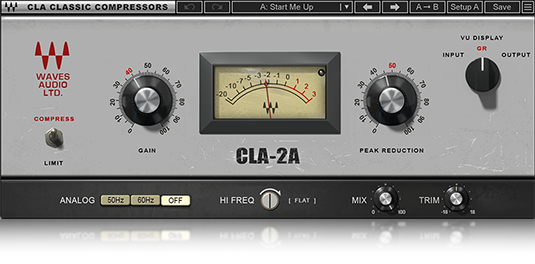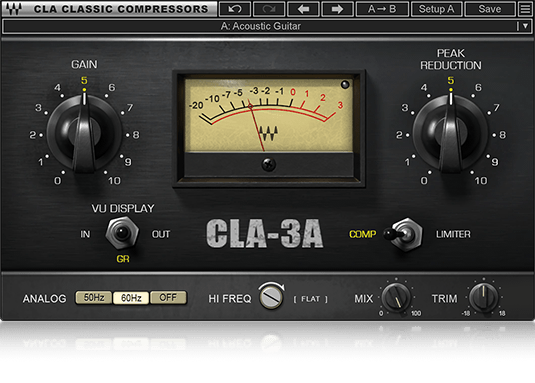Waves collaborated with the renowned mix engineer Chris Lord-Alge (CLA) to emulate three classic compressors, which are modeled after some of his favorites from the past.
In this blog post, we will compare three popular compressor plugins developed by Waves Audio: CLA-2A, CLA-3A, and CLA-76.
Whether you're a seasoned pro or just starting out in the world of audio production, you won't want to miss this informative and highly engaging breakdown of the CLA compressor lineup.
Differences Between CLA-2A, CLA-3A, and CLA-76 Compressors
When it comes to compressors, there are few names in the industry that carry as much weight as Chris Lord-Alge (CLA).
The legendary mix engineer has been responsible for shaping the sound of countless hit records, and his signature line of compressors has become a go-to tool for producers and engineers worldwide.
But with three different models to choose from—the CLA-2A, CLA-3A, and CLA-76—it can be tough to know which one is right for your mixes.
Today, we take a deep dive into the differences between these compressors, examining their unique characteristics and exploring the best applications for each.
So, without further ado, let's dive into the differences between these three amazing compressors.
CLA-2A Compressor

The CLA-2A is a plugin emulation of the Teletronix LA-2A, a classic analog compressor that has been used on countless recordings since the 1960s.
Famous for its smooth, warm, and musical compression, and the CLA-2A replicates those characteristics beautifully.
It only has two knobs: Gain and Peak Reduction.
The Gain knob adjusts the output level, while the Peak Reduction controls the amount of compression.
Peak reduction is essentially a threshold control, but it also affects the release time of the compressor. The lower you set the peak reduction, the longer the release time, which can add sustain and warmth to a sound.
The CLA-2A is ideal for vocals, acoustic guitars, bass, and any instrument that needs gentle, musical compression.
It can also add a lovely sheen to your sounds.
But it's not the best choice for aggressive or fast transients.
The Classic CLA-3A

The CLA-3A emulates the Universal Audio LA-3A, another classic analog compressor.
It is similar to the CLA-2A but has a faster attack time and a more transparent sound. The CLA-3A has the same two knobs as the CLA-2A: Gain and Peak Reduction.
However, the peak reduction controls the ratio of compression rather than the threshold.
The higher you set the peak reduction parameter, the higher the compression ratio, which can make the sound more aggressive.
This makes it an excellent choice for drums, electric guitars, and any instrument that needs a fast and transparent compressor.
It's not as warm and musical as the CLA-2A, but it can add punch and clarity.
Iconic CLA-76
The CLA-76 is a software emulation of the Urei 1176, which is an iconic FET compressor from the 1960s.
It’s well known for its fast attack time, high ratio, and aggressive sound.
Unlike the previous compressors, the CLA-76 has four knobs: Input, Output, Attack, and Release.
The Input and Output knobs adjust the gain reduction and output levels, respectively. The attack and Release knobs control the envelope of the compressor.
The faster you set the attack time, the faster the compressor will react to transients, which can add punch and aggression to a sound.
The CLA76 is perfect for drums, bass, and any instrument that needs a fast and aggressive compressor.
Although it’s a versatile compressor, it's not the best choice for acoustic instruments, as it can make them sound too harsh and unnatural.
Commonly Asked Questions
Here’s a Q&A to help you choose the right CLA compressor for your needs and achieve the desired sound for your mix.
Is the LA-2A Fast or Slow?
The LA-2A compressor is generally considered a slow compressor due to its relatively slow attack time and release time.
It uses an optical gain reduction element to apply compression, which has a relatively slow response time compared to other types of compression.
This slower response time contributes to its warmth and smoothness, making it a popular choice for vocals, bass, and other instruments where gentle, musical compression is desired.
What is the LA-2A Good For?
Its unique characteristics make it a popular choice for a variety of applications.
Here are some of the most common uses for the LA-2A compressor:
- Vocals: It's an excellent choice for vocal compression, as it can add warmth and smoothness to the sound while controlling the dynamic range. It can help even out the performance and make it sit well in the mix.
- Bass: The LA-2A is also well-suited for bass guitar, as it can add warmth and thickness to the sound while controlling dynamic peaks. It can give the bass a full, round sound.
- Acoustic guitar: It’s also great to gently compress acoustic guitar, adding warmth and smoothness. It usually adds a sense of depth and dimension to acoustic guitars.
- Drums: While the LA-2A may not be the best choice for aggressive drum compression, it can be used to gently control peaks and add warmth to the overall drum sound. It can be particularly effective on the snare and kick drums.
Its warm, smooth sound makes it particularly well-suited for vocals, bass, and acoustic instruments, but it can be effective on a range of other instruments as well.
Why is the LA-2A Good for Vocals?
The LA-2A is a popular compressor for vocal processing because it has a warm, smooth sound that can help even out the performance and add a sense of depth and dimension to the vocals.
Here are some of the reasons why the LA-2A is particularly well-suited for vocal processing:
- Optical gain reduction: This gives it a relatively slow response time compared to other types of compression. A slower response time can give the vocals an organic feel.
- Gentle compression: The LA-2A can help control dynamics without sounding overly processed or squashed. This makes it well-suited for vocal processing, where a natural, dynamic sound is often desired.
- Smooth sound: A warm and smooth sound often adds depth and dimension to the vocals, making them sound more polished and professional. This can be particularly effective on lead vocals or other prominent vocal tracks.
- Easy to use: With just a few controls for adjusting the input gain, output gain, and compression level, this makes it a popular choice for producers and engineers who want a straightforward compressor that can deliver excellent results with minimal tweaking.
Is the CLA-3A Better than the CLA-2A?
The CLA-3A and the CLA-2A are both modeled after iconic vintage compressors and have their own unique characteristics.
Which one is better largely depends on personal preference and the specific application.
Here are some differences between the CLA-3A and the CLA-2A:
- Opto vs. electro-luminescent gain reduction: The CLA-2A uses an opto-gain reduction element, while the CLA-3A uses an electro-luminescent (EL) gain reduction element. This gives the CLA-3A a faster attack time and a more aggressive sound, while the CLA-2A has a slower attack time and a more gentle sound.
- Fixed ratio vs. variable ratio: The CLA-2A has a fixed compression ratio of 4:1 (but the ratio will fluctuate depending on the source), while the CLA-3A has a variable ratio that can be adjusted from 2:1 to 10:1. This gives the CLA-3A more flexibility in terms of how much compression is applied to the signal.
- Mid-range emphasis vs. overall warmth: The CLA-3A has a slight mid-range emphasis that can help bring out the detail and clarity in a mix, while the CLA-2A has an overall warmth and smoothness that can help thicken up a sound.
- Electric guitar vs. bass compression: The CLA-3A is often used for electric guitar compression, as it can help control dynamic peaks and add clarity and detail to the performance. The CLA-2A is often used for vocal and bass compression, as it can help add warmth and thickness.
Overall, both compressors have their strengths and weaknesses, and which one is better depends on the specific application and personal preference.
